Transports
Let’s stop the radioactive shipments through our threathened Baltic Sea!
Image location: http://www.kimointernational.org/Portals/0/Files/image.jpg
Containership containing Uranium Oxide has collision in Oeresund
http://nyhederne.tv2.dk/article.php/id-23468448.html?rss (Danish TV2 News, 03-07-2009)
“This incident highlights the risk in transporting nuclear materials by sea. On the 4th July the containership “Kapitan Lus” carrying uranium oxide had a collision with a Norwegian freighter carrying methanol near the Oeresund bridge between Sweden and Denmark. The Russian Kapitan Lus was holed below the waterline as shown in the video below but fortunately there was no release of uranium.
This incident however highlights the dangers of transporting radioactive substances by sea through areas of high population and could have been much worse had the methanol on board the second freighter caught fire. The Kapitan Lus also regularly carries uranium hexafluoride a much more dangerous cargo.
KIMO (Kommunenes Internasjonale Miljöorganisasjon, Local Authorities International Environmental Organisation) believes that this incident shows that it is only a matter of time before we have a serious incident with a vessel carrying nuclear material and that where possible these shipments should be stopped or as a bare minimum transported in purpose built vessels with a military escort. (http://www.kimointernational.org/)
The implications of this accident are very serious – and we need to keep pointing that out: the Russian ship could just as well have been carrying UF6 (uraniumhexaflouride) which it has often before. UF6 reacts violently if in contact with water… In combination with the other ship carrying methanol – it seems there were the basis for an explosive fire, possible breach of containers and release of the radioactive contents. The accident happened almost directly below the Oresund bridge, in the narrow straight between Denmark and Sweden – right in center of the most populated region of the Nordic Countries!
Fires on ships tends to burn longer than on land, and may reach temperatures which are much higher, than what containers can withstand – according to KIMO’s experts:
”in an incident involving a severe long-term fire, breaching shipping casks and/or sinking a nuclear transport vessel, the consequences would be comparable to the most severe accident that authorities insist is too improbable to be considered,”
See KIMO’s report: ”Report on the Transport of Mixed Oxide Fuel and other Radioactive Cargoes by Ship in Europe (Revised 2006)” downloadable from: http://kimo.octeportal.co.uk/Portals/0/Files/KIMO%20Transport%20of%20Mixed%20Oxide%20Fuel.pdf
Especially see page 9 & 10 – where it tells of a close call of disaster, when Swedish nuclear transports carrier, Sigyn, in 2004 carrying spent nuclear fuel was on collission course with a large Asian freighter, which didn’t respond to emergency communication.
Swedish authorities viewed it as a very serious incident: (link in Swedish)
http://www.sr.se/ekot/arkiv.asp?DagensDatum=2004-03-03&Artikel=378625
The 360 kg of enriched Uranium traveling 2.500 km by train to Mayak, Russia
IAEA:s VIDEO:
http://www.iaea.org/NewsCenter/Multimedia/Videos/CNNUnifeed/Rez/index.html
HELCOM report shows a 12% increase in ship accidents in the Baltic
http://www.helcom.fi/press_office/news_helcom/en_GB/Ship_accidents_2008_report
“Helsinki, 12 June (HELCOM Information Service) – As there are more and more cargo ships, tankers, and ferries plying the waters of the Baltic Sea every year, the number of accidents at sea has gone up again, especially in such a busy traffic area like the Danish Straits, according to the latest HELCOM study. But the occurrence of ship-to-ship collisions, one of the most serious types of accidents at sea, remains at the same level.
Analysis of the data contained in the latest annual reports provided by the Member States to HELCOM reveals that overall there was a total of 135 ship accidents in the Baltic marine area in 2008, which is 15 more than the year before (12.5% increase) and 18 more than in 2006 (15% increase).”…
The report on shipping accidents in the Baltic Sea area for the year 2008:
http://www.helcom.fi/stc/files/shipping/shipping_accidents_2008.pdf

